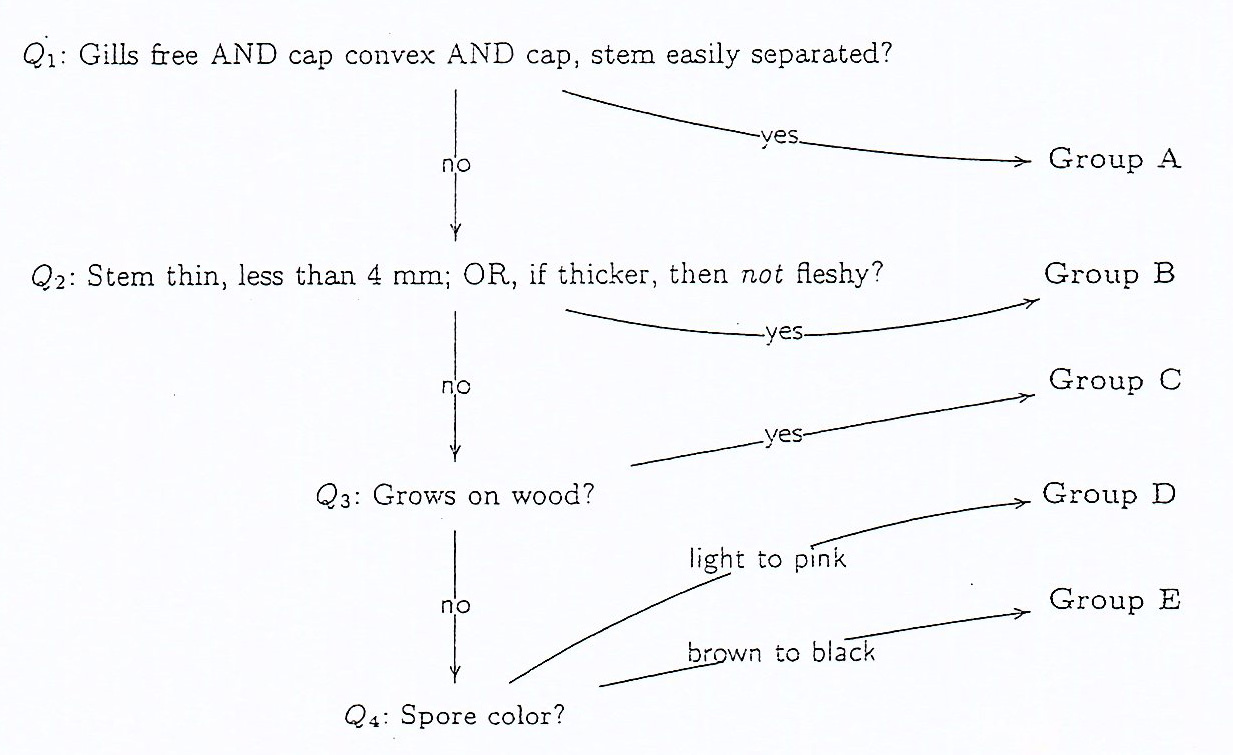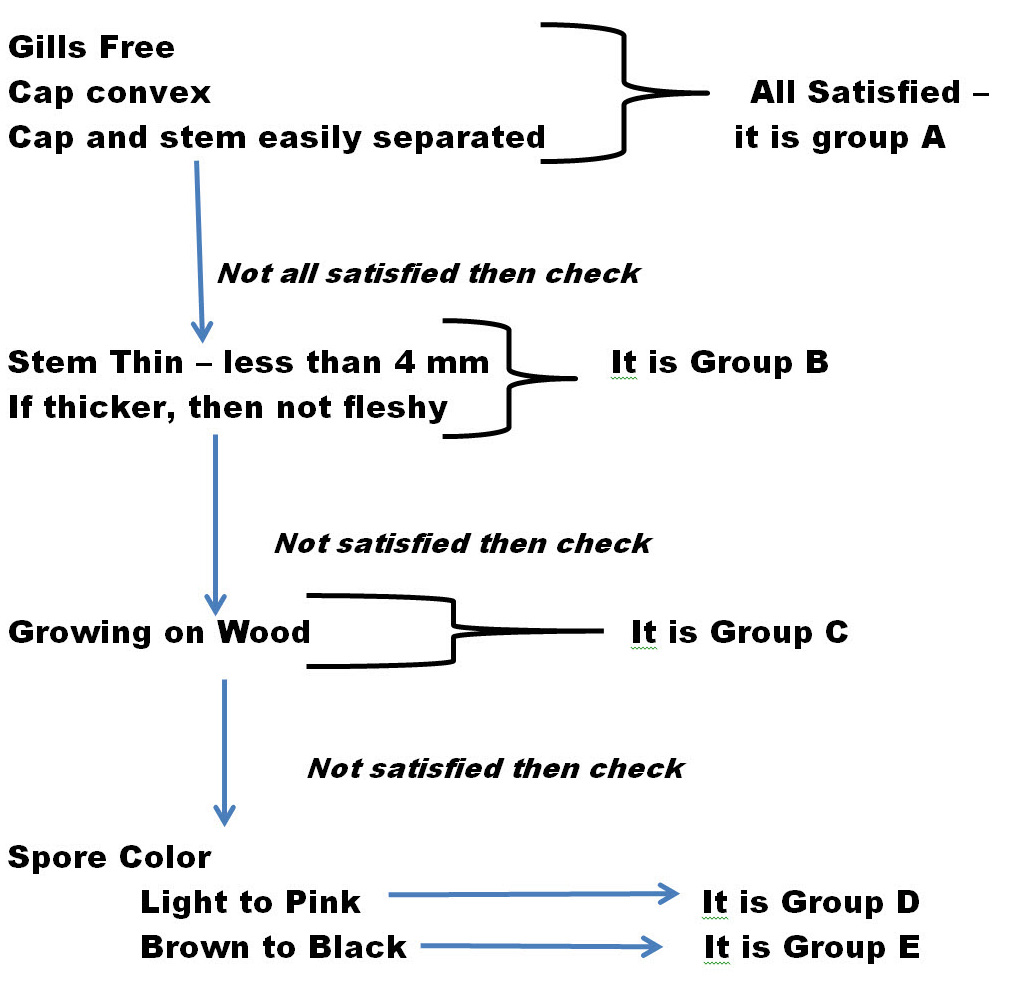<
How to Identify
The Group of a speciment on the
Kit Scates chart
"Easy Key to Common Gilled Mushrooms"
Adaped from material presented in class by Sava K.
First, how to identify the group of a
specimen is discussed
Second, the genera that are in each group is discussed
Diagram showing how to identify the group of a specimen

Chart giving the characteristics of specimens in each step of the identification process shown above

Comments on how to identify the group of a speciment
Test 1: Are the gills free: It is sometimes not easy to determine if gills are free because
gills may be almost free (finely attched). Treat "almost free" as "free".
Check to determine if the cap and stem separate
cleanly, that is, are the gills free. If the cap and stem separate cleanly the specimen is in group A.
If they do not separate cleanly , move to Question 2.
Test 2: Is the stem less than 4mm or less in diameter. If it is thicker than 4mm is it fleshy.
It is in group B if the stem is less than 4mm or if the stem is larger than 4mm the stem is
NOT fleshy. If the sterm is fragil or hallow or if
it bends readily it is not considered to be fleshy. If it is solid and breaks whey you try to flex it, then it is fleshy and
it is fleshy and it is not in broup B.
Test 3 : Was the specimen growing on wood: Note that a mushroom may grow on a dead branch
that is burried in the soil and appear to be terrestrial when it is not. Check the bottom of the stem,
to see if it is connected to burried wood.
Discussion of the genera in each of the groups A to E
Group A: Free Gills
There are only four common genera in this group and they can be told apart by the spore color
and the presence of (remnants of) universal veil.
The spores will be white, pink, or dark brown.
If brown, you have an Agaricus and you will (to confirm your ID) also see a membranous ring on it, and no volva.
If the spores are pink, your mushroom is a Pluteus; it should be growing on wood and have no ring nor volva.
The lignicolous habit alone distinguishes Pluteus from the other three Group A genera, which are all terrestrial.
White spore print indicates Amanita or Lepiota. Every Amanita should display the remnants of the universal veil,
either as a volva, or as (usually removable) patches or warts on its cap.
Lepiota does not have universal veil, but its stem is often bulbous and its cap often scaly,
which may make you confuse it with Amanita.
However, the scales in Lepiota are a genuine part of the cap surface and are not easily
scraped off.
The stem consistency can also help you distinguish these two genera:
in Amanita, the stein is fleshy, and in Lepiota it is often tough (you wouldn't think of cooking it).
As for the ring, Lepiota will always have it, but some Amanitas are ringless.
Finally, note that what we are calling Lepiota here is a group of genera: Lepiota sensu stricto, Chlorophylluni, Leucoagaricus,
Group B: Slim Stems
Genera:
Mycena, Omphalinoid gp., Collybia/Gymnopus,
Marasmius, Galerina, Conocybe,
Bolbitius, Psilocybe, Panaeolus,
Psathyrella, Coprinus
Group C: On wood
Genera:
Armillaria, Pleurotus, Lentin(el)us,
Tricholomopsis, Crepidotus, Gymnopilus,
Pholiota, Tapinella, Hypholoma
Group D: Light Spores
A mushrooms belongs to this group if it has
- gills that are not free
- fleshy stem
- terrestrial habitat
- spore print color light to pink
The genera here fall into five subgroups, defined as follows.
D1 Flesh and stem brittle -- Russula, Lactarius
D2 Annulus present -- Tricholoma (part), Cathatelasma, Cystoderma
D3 Gills distant and waxy --- Hygrophorus, Hygrocybe, Laccaria
D4 Spore print pink ---- Entoloma, Clitopilus, Lepista
D5 None of the above -- Tricholoma, Melanoleuca, Clitocybe, Lyophyllum, Leucopaxillus, Hygrophoropsis
The properties defining the subgroups D1-D4 are mutually exclusive.
That is, it is unlikely that you will find a pink-spored mushroom with an annulus,
or a brittle mushroom with waxy gills, etc.
To determine a genus within a subgroup, use the following comments
Subgroup D1
The brittleness of Russulas and Lactarii is often described by "their stem breaks like a chalk" .
Or: "if you hit a tree with a Russula, the mushroom will break into pieces" .
To tell these two genera apart, just note that every Lactarius exudes milk and no Russula does.
Subgroup D2
You will recognize a Cystoderma by its smaller size and (most importantly) the granular or powdery
covering on both cap and stem.
Catathelasmas have a distinct double-layered annulus, which separates them from ringed Tricholomas.
A Catathelasma is also likely to be much bigger than a Tricholoma and to have decurrent gills.
Note. If you've found a D2-mushroom that grows in clusters, it's probably an Armillaria (from Group C) that only appears to be terrestrial.
Subgroup D3
Unfortunately "gills waxy" is not an easy test at first;
you will need to see a few Hygrophorus mushrooms to get a good sense of it.
"The 'waxyness' is admittedly an ambiguous character, but with a little experience is readily
apparent-the gills are characteristically soft, clean, fleshy, and ... they look (and often feel) waxy" [Arora].
Laccaria's gills are a bit less waxy, but what distinguishes a Laccaria from a Hygrophorus is pinkish,
violaceous, or purple gills and stems that are often longitudinally fibrillose.
Subgroup D4
Decurrent gills point to Clitopilus and attached gills to Entoloma or Lepista.
Without a microscope, an Entoloma vs. Lepista dilemma may be unsolvable.
One source says that Lepista spores are "pinkish buff", and those of Entoloma are "rose beige to blush"; if this is not telling you much, you're not alone.
The reality is that there is one common Lepista (the blewit) and you will soon learn to recognize it directly.
Subgroup D5
This is a challenging collection of genera and some distinctions between them (and Lepista in D4)
often cannot be made confidently without chemical or microscopic tests.
It is important to determine gill attachment,
but it is not consistent with the genera in D5 and does not have distinguishing power taken alone.
The gill attachment is as follows
Tricholoma -- Adnexed or Notched
Melanoleuca -- Notched or Adnate
Lyophyllum -- Notched, Adnate or Decurrent
Clitocybe -- Adnate or Decurrent
Leucopaxillus -- Adnate or Decurrent
Hygrophoropsis -- Decurrent
Organized differently
Adnexed -- Tricholoma
Notched -- Tricholoma or Melanoleuca or Lyophyllum
Adnate -- Melanoleuca or Lyophyllum or Clitocybe or Leucopaxillus
Decurrent --Lyophyllum or Clitocybe or Leucopaxillus or Hygrophoropsis
The only genus that's easy to separate from the rest here is Hygrophoropsis: you will recognize it by decurrent orange gills, and you will then even know
the species-it's H. aurantiaca (the false chanterelle), the only Hygrophoropsis in D5
You can also expect to identify Melanoleuca based on this set of features:
stem striate (marked lengthwise with delicate lines),
often slender;
cap broad in relation to the stem, smooth, convex with a small umbo.
With the remaining four genera, use the following tips.
- If it grows in clusters, it's most likely a Lyophyllum, but may be Clytocybe too
(especially if the mushroom is white).
- If the flesh and/or gills markedly stain black or blue where bruised, then it's a Lyophyllum.
- If the gills are notched and spore print is white, it's most likely a Tricholoma, but may be a Lyophyllum.
- If the cap and stem are unusually tough (mushroom remains whole when you hit a tree with it),
then it's a Leucopaxillus.
- A conspicuous white mycelial mat at the stem base, binding it to the humus substrate,
is an indication of a Leucopaxillus.
Group E: Dark Spores
Genera: Gomphidius, Chroogomphus, Paxillus,
Stropharia, Agrocybe, Cortinar-Inocybe,
Hebeloma, Phaeocollybia
